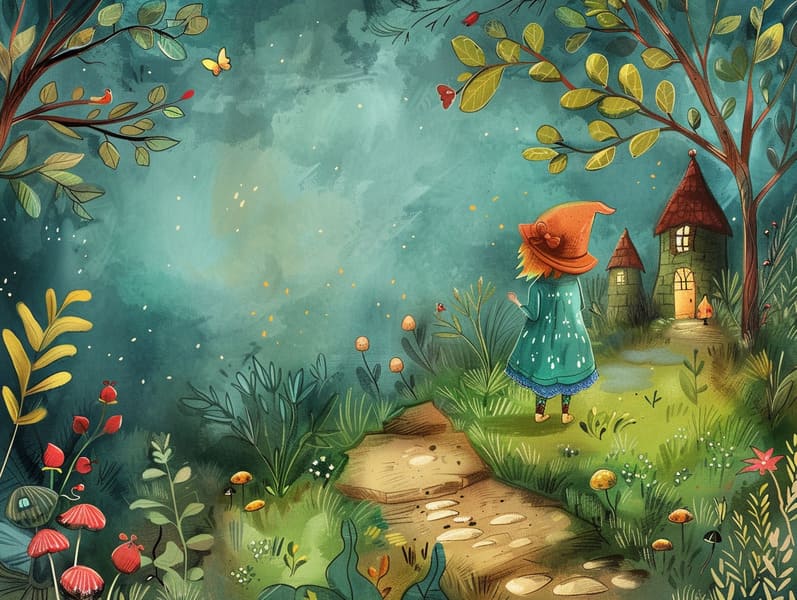
Fairy tales have timeless appeal. These narratives have been recounted from one generation to the next well before they were ever put on paper. They developed from a variety of traditions, including Eastern traditions. They were initially conveyed among grown-ups, often carrying themes and messages pertaining to the societal norms and beliefs of the time.
The Brothers Grimm, Jacob and Wilhelm, were among the first to collect and release many of these beloved fairy tales. Their compilation, "Grimm's Fairy Stories," included classics like "Cinderella," "Hansel and Gretel," and "Snow White," which have since become mainstays in the world of traditional fairy tales. Similarly, Hans Christian Andersen's enchanting tales, such as "The Mermaid's Tale," and "The Little Duckling," have captivated hearts worldwide, ensuring their place in the pantheon of famous fairy tales.
Despite being ancient, these tales remain as meaningful as ever, especially as nighttime stories for kids. These magical stories are now available in multiple formats, including vibrantly illustrated books, charming animations, and internet fairy tales.
Their ongoing significance can be linked to several magical reasons:
Significant Morals: Traditional fairy tales often illustrate important moral lessons. Tales like "The Tale of the Boy Who Cried Wolf" teach the virtue of honesty, while "The Tale of the Tortoise and the Hare" exemplify the values of perseverance and unassuming nature. These stories offer young readers clear distinctions between right and wrong, building their moral compass in a mild yet significant way.
Warmth and Understanding: Classic fairy tales frequently depict figures facing trials and tribulations, prompting young listeners to feel with their struggles and back their triumphs. For instance, "Beauty's Beast" conveys the value of appreciating inner worth to comprehend the inner self of a individual, encouraging understanding and recognition.
Cultural Insights: Many old fairy tales are deeply embedded in the cultural contexts from which they bloomed. Exploring these fairy tales can provide intriguing perspectives into different customs, building a sense of global awareness and acknowledgment.
Fantasy and Imagination: The imaginative elements in traditional fairy tales—magical kingdoms—kindle children’s innovative ideas. These stories lead readers to magical realms, stimulating creative ideas and a sense of amazement that lasts a lifetime.
Old fairy tales are not only fantastical but also edifying. They provide fascinating tools in cultivating various intellectual and emotional capacities in young readers. When timeless fairy tales are read aloud, they strengthen language proficiency by teaching new linguistic elements and elaborate sentence structures. This practice also strengthens listening skills and mental focus, as little ones pay close attention, prepared to see what happens next.
Furthermore, analyzing the themes and characters of fairy tales can enhance evaluative skills and evaluative skills. Young ones are led to identify patterns, make predictions, and grasp cause and effect. These talks also boost kids voice their thoughts and feelings, nurturing their emotional intelligence.
In today’s high-tech era, the abundance of digital storybooks has made these fairy tales more attainable than ever. Internet sites and apps share extensive collections of popular fairy tales that can be seen or listened on anytime, anywhere. Fairy tales read aloud are particularly liked, making available an captivating way for children to engage with these enchanting tales. Sound books and spoken videos carry characters and settings to life, often paired with mesmerizing music and songs that augment the tale journey.
The unending appeal of ancient fairy tales lies in their ability to adjust to modern times while retaining their key morals. Contemporary adaptations of these tales often introduce more multicultural characters and modern settings, making them pertinent to today’s audience. However, the main ideas of daring, kindness, and impartiality remain unchanged, continuing to connect with kids of all ages.
Traditional fairy tales also offer a sense of security and recognition. They make available a orderly narrative with a recognizable beginning, middle, and end, often concluding with the solving of conflicts and the triumph of morality over wickedness. This consistency can be solacing for kids, delivering a sense of firmness in an always shifting world.
Timeless fairy tales continue to bewitch and teach new generations, maintaining their captivation and applicability in modern society. As children's night stories, they showcase a perfect blend of allure and teaching, encouraging moral values, empathy, and creativity. The accessibility of online fairy tales and the likability of fairy tales read aloud promise that these classic stories remain obtainable to new generations.
By conserving and passing on these tales, we continue to acknowledge read more the rich tapestry of lore and cultural heritage. Whether you are seeing a richly illustrated book, perusing a virtual library, or listening on an audio story, the magic of famous fairy tales is always within reach. These fairy tales remind us of the enduring impact of stories and its ability to hold us together across generations and cultures.
No matter if you are experiencing a gorgeously illustrated book, discovering a web-based collection, or listening via an read-aloud book, the charm of bedtime fairy tales is always within reach.
These stories emphasize of the enduring presence of storytelling and its ability to gather us across generations and cultures, weaving a spell that charms and informs alike.